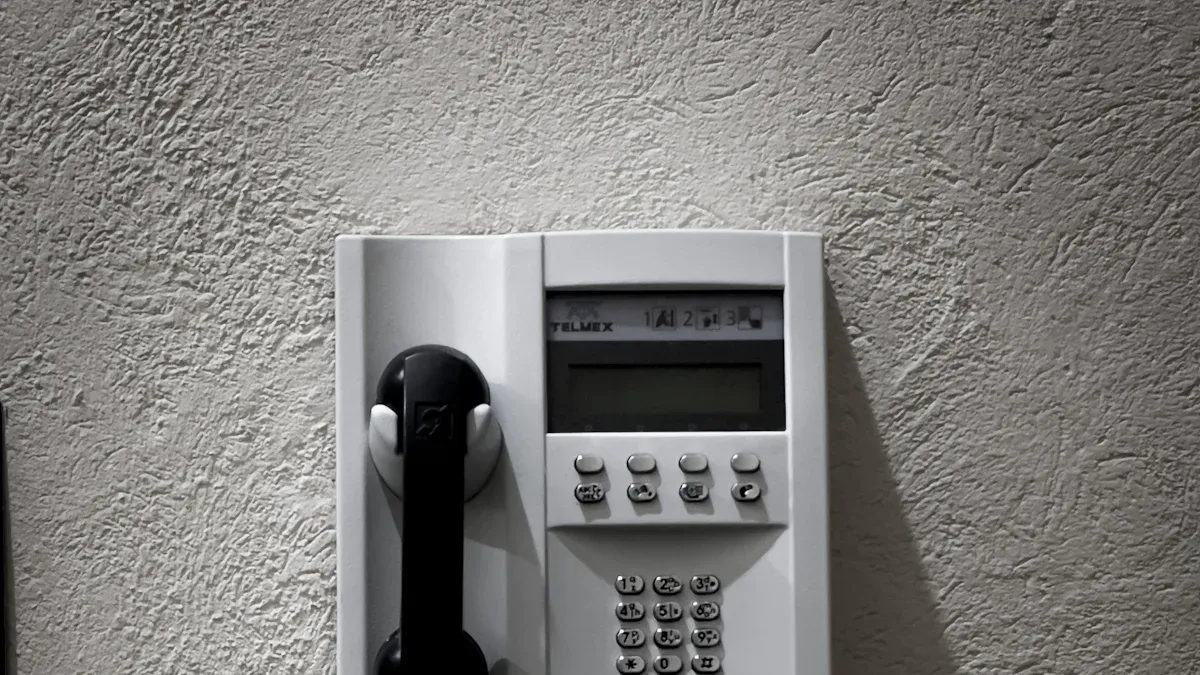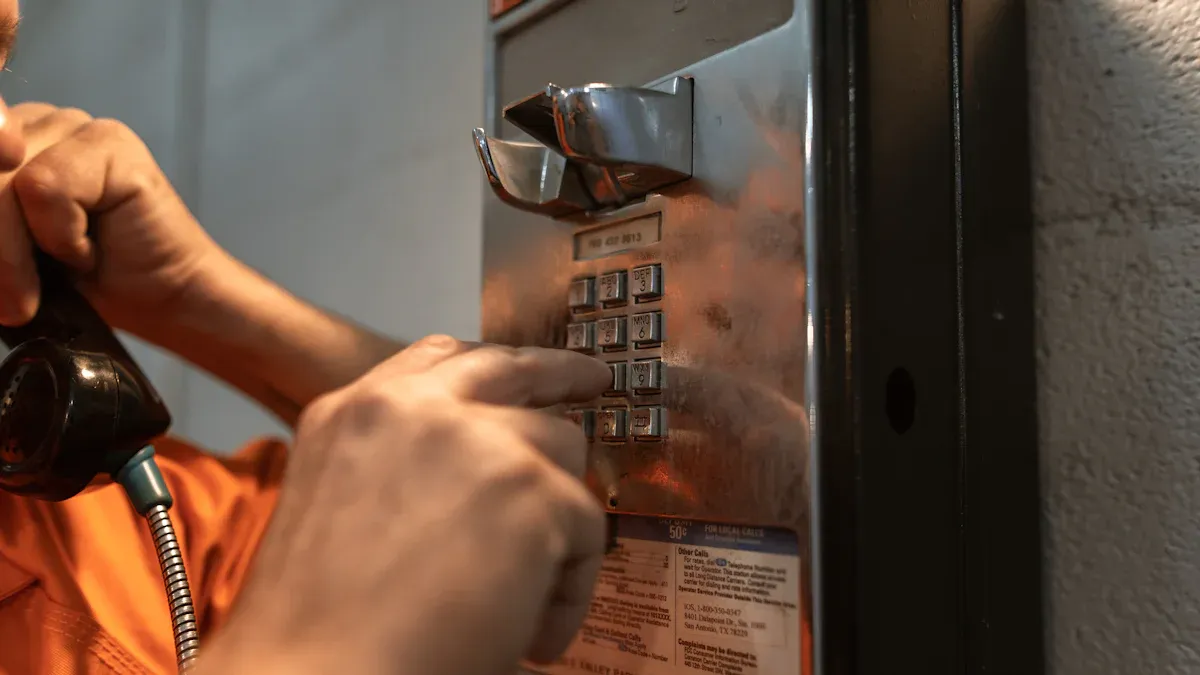
A Prison Telephone Handset comes with specific engineering. These features prevent misuse. They also ensure reliable communication for users. Manufacturers integrate robust materials, tamper-proof construction, and controlled communication capabilities. This design directly addresses the dual demands of security and functionality within correctional facilities.
Key Takeaways
- Prison phones are very strong. They use tough materials and special building methods. This stops inmates from breaking them or using them for bad things.
- These phones have strict rules. They only let inmates call approved numbers. This helps keep the prison safe and stops illegal plans.
- Even with all the security, prison phones must work well. They have clear sound and are easy to use. This helps inmates talk to family and lawyers.
The Dual Imperatives for a Prison Telephone Handset
Security Needs: Preventing Misuse and Unauthorized Communication
Prisons face constant challenges. They must stop inmates from misusing communication tools. Think about it: preventing contraband or escape plans often starts with controlling conversations. A Prison Telephone Handset plays a key role here. It prevents unauthorized calls. It also stops inmates from planning illegal acts. Authorities need to monitor conversations closely. They must ensure no one tampers with the phone itself. This means the handset needs strong security features. It stops inmates from breaking it or using it for bad purposes. The design must make sure only approved calls happen. It also needs to resist attempts to bypass its systems. This protects both the facility and the public.
Functional Needs: Ensuring Reliable and Accessible Communication
Even with strict security, the phone must work well. Inmates need to talk to their families. They also need to speak with lawyers. This communication helps their mental well-being. It also supports their rehabilitation process. Imagine the stress of being cut off! The handset must be easy to use for everyone. It needs clear sound, even in noisy common areas. It should also last a long time, handling constant use and potential rough treatment. This ensures everyone can access it when they need to. A reliable phone helps maintain order inside the facility. It gives inmates a vital, controlled link to the outside world, which is crucial for their human rights and eventual reintegration.
Core Design Elements for Prison Telephone Handset Security

Designing a phone for a prison means thinking about security first. Engineers build these devices to withstand tough conditions and prevent any misuse. They focus on materials, construction, communication controls, and how the phone gets power and connects.
Material Selection for Tamper Resistance
Manufacturers choose materials for prison phones that are incredibly strong. They often use stainless steel or tough, reinforced plastics like polycarbonate. These materials resist cutting, smashing, or prying. For example, a phone casing made from hardened steel makes it very difficult for anyone to break it open. This stops inmates from getting to the internal parts. It also prevents them from turning pieces of the phone into weapons. The goal is to make the phone so robust that it cannot be easily damaged or altered. This protects the phone’s integrity and keeps the facility safe.
Anti-Vandalism Construction and Assembly
Building a secure phone goes beyond just strong materials. Designers use special construction methods to prevent vandalism. They often seal the phone’s enclosure completely, leaving no gaps or seams. Hidden fasteners secure all parts, so inmates cannot easily unscrew or remove them. Buttons are often recessed or made from solid metal, making them hard to pry off. The cord connecting the handset to the base is usually armored, protecting it from cuts or pulls. This robust assembly means the phone can handle constant, rough use. It also makes it nearly impossible to tamper with the internal electronics. Every part fits together tightly, creating a solid, tamper-proof unit.
Communication Restrictions and Monitoring Capabilities
Security features also control how inmates use the phone. Prison systems only allow calls to pre-approved numbers. This means inmates cannot call just anyone; they can only reach people on a whitelist. Authorities record all conversations. Sometimes, staff even monitor calls live. This helps prevent illegal activities or escape plans. The system can also limit call durations, ensuring fair access for everyone. These restrictions stop unauthorized communication. They give prison staff important tools to maintain order and safety within the facility. A Prison Telephone Handset becomes a controlled communication tool, not a free line to the outside world.
Secure Power and Connectivity for the Prison Telephone Handset
The way a prison phone gets power and connects to the network is also very secure. Engineers design these systems with low voltage to prevent electrical hazards. They protect all wiring inside armored conduits, making it impossible for inmates to cut or tap into the lines. The phone connects to an isolated network, separate from the prison’s main systems. This prevents any attempts to hack or interfere with the communication infrastructure. Power supplies are often internal and tamper-proof. This secure setup ensures the phone always works reliably. It also stops inmates from using the phone’s power or connection for any unauthorized purpose.
Core Design Elements for Prison Telephone Handset Functionality

While security is paramount, a prison telephone handset must also work well. It needs to be easy to use and reliable. Designers focus on several key elements to ensure inmates can communicate effectively.
Ergonomics and Usability for Inmate Access
Designers make these phones simple for everyone to use. They often include large, easy-to-press buttons. This helps inmates with different hand sizes or those who might have physical limitations. Numbers and letters are clear and easy to read. The handset itself fits comfortably in a hand, making calls less awkward. A simple interface means inmates do not get confused. This thoughtful design ensures more inmates can easily connect with their families or legal counsel. It promotes accessibility for all users.
Tip: Good ergonomic design reduces frustration and encourages proper use, even in a high-stress environment.
Audio Quality in Noisy Environments
Prisons are often loud places. Think about common areas or busy cell blocks. A prison telephone handset must cut through this noise. Manufacturers equip these phones with special noise-canceling microphones. These microphones block out background sounds. Powerful speakers ensure the inmate can hear clearly, even with commotion around them. Users can often adjust the volume to suit their needs. The handset’s shape also helps. It creates a small barrier, keeping outside sounds away from the ear. Clear sound makes conversations less stressful and more productive for everyone involved.
Reliability and Longevity Under Constant Use
These phones work hard every single day. Many people use them, sometimes roughly. Designers build them to last. They use strong internal components that resist wear and tear. The materials chosen for the casing and buttons do not break down easily. Buttons can handle countless presses. Cords do not fray quickly. The phone has few moving parts. This reduces the chances of something breaking. This robust design ensures the phone stays working. It provides reliable service for a long time, minimizing downtime and repair needs.
Maintenance and Repair Without Compromising Security
Even the toughest phones sometimes need fixing. Prison staff must do this safely. Designers make the phones with parts that are easy to swap. This allows for quick repairs. Special tools are often needed to open the phone. This keeps it secure during maintenance. Quick fixes mean the phone is back in use fast. The design also allows for easy cleaning and sanitization. This keeps the phone hygienic for all users. Maintenance happens efficiently without risking the facility’s security. This balance keeps the communication lines open and safe.
Integrating Security and Functionality in Prison Telephone Handset Design
Designers carefully blend security and usability in prison phones. They create devices that protect the facility. They also allow inmates to communicate effectively. This integration requires smart engineering choices.
Integrated Circuitry and Secure Software
Modern prison phones use advanced internal systems. Secure software controls every call. It ensures only approved numbers receive calls. The system records conversations for monitoring. It also encrypts data to prevent unauthorized access. This integrated circuitry makes the phone smart and secure. It manages call durations and access times. This prevents misuse while providing essential communication services. The software works silently in the background. It keeps the communication lines safe and controlled.
Physical Design Innovations for Robustness and Usability
Physical design combines strength with ease of use. Manufacturers create handsets from tough, impact-resistant materials. Yet, they shape them for comfortable holding. Buttons are often metal or sealed. This prevents tampering. Still, they offer a clear, tactile response. Armored cords resist cutting. They also remain flexible enough for natural movement. These innovations ensure the phone withstands harsh conditions. They also make it simple for inmates to operate. This balance means the phone lasts longer and works better.
Regulatory Compliance for Prison Telephone Handsets
A Prison Telephone Handset must meet strict rules. These regulations cover safety, security, and accessibility. Compliance ensures the phone protects both inmates and staff. It also guarantees fair access to communication. Authorities set standards for tamper resistance and monitoring capabilities. They also require features for inmates with disabilities. Meeting these rules means the phone is reliable. It also upholds legal and ethical standards within correctional facilities.
Designing a prison telephone handset requires careful thought. It balances strong materials, tamper-proof construction, and controlled communication. It also includes easy-to-use features for inmates. This design makes sure the phone works well in a secure place. It meets all security rules and communication needs.
FAQ
Why are prison telephone handsets built so tough?
Manufacturers build them tough to prevent inmates from breaking or tampering with them. Strong materials and secure construction keep the facility safe.
Can inmates call anyone they want from a prison phone?
No, they cannot. Prison phones only allow calls to pre-approved numbers. This system prevents unauthorized communication and maintains security.
How do prison phones ensure clear audio in noisy areas?
Prison phones use special noise-canceling microphones. Powerful speakers ensure inmates hear clearly. This design helps conversations remain understandable, even in loud environments. 🗣️

